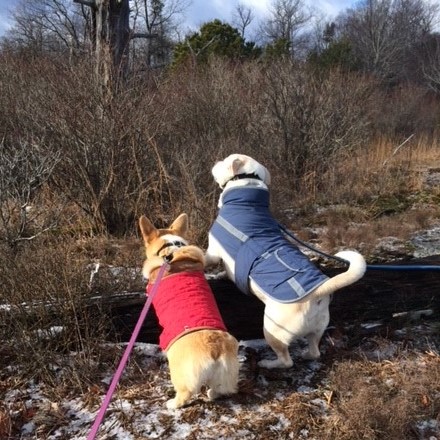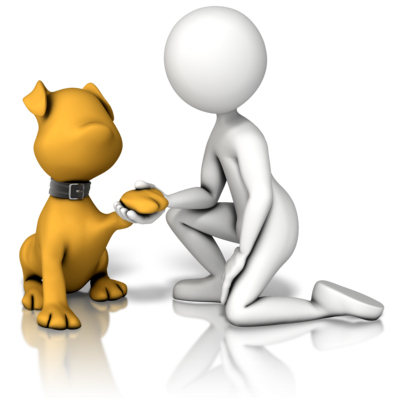Ah, man’s best friend (and woman’s too!) – a dog. Dogs enrich our lives in so many ways. An endless source of unconditional love, loyalty, and support. A companion, a protector, and a pal to take away sadness or pain…. we get all this and much more from our dogs. I should know: I’m on my third and fourth dogs now. I wasn’t allowed to have pets growing up, so I’m making up for lost time. If I could own many dogs at once, I would.
Since the weather is (hopefully) going to become less sweltering this Fall, it’s time to really get out and be active with our dogs. I can just hear my double-coated Corgi, Zara, saying “C’mon, it’s not so hot anymore. Let’s just go out and have some FUN!”
But with dog ownership comes responsibilities – and the need to train that pup. And many of us decide that raising our voices will be effective for training, disciplining, etc. Let’s face it: we even raise our voices in joy when our dog does something adorable or brilliant. (Each of us has the most brilliant or adorable dog in the world, n’est-ce pas?). I’m sure many of us have used silly goofy voices to talk to our fur babies. Not to mention, the shriek that we let out when we see a pile of splinters on the floor under what used to be the corner of the coffee table. Yes, my Zara did that, to several pieces of furniture. Sigh.
 All that extreme voice use can create problems for your vocal mechanism. If you yell at that poor pooch because of an unfortunate accident on the rug, you run the risk of crashing your vocal folds (i.e., vocal cords) together much too forcefully. If that continues, you run the risk of developing possible vocal fold pathology like nodules. If you shout across the yard or scream your commands when something goes wrong during your training sessions (with my dogs, it’s the sudden appearance of a bunny on the lawn), you may end up becoming hoarse and scratchy, or develop a sore aching throat and strained voice. If you do it enough, you can lose your voice, either intermittently or chronically. It’s no wonder that some of my voice therapy clients are dog trainers who did not have the skills to meet the vocal demands of their jobs.
All that extreme voice use can create problems for your vocal mechanism. If you yell at that poor pooch because of an unfortunate accident on the rug, you run the risk of crashing your vocal folds (i.e., vocal cords) together much too forcefully. If that continues, you run the risk of developing possible vocal fold pathology like nodules. If you shout across the yard or scream your commands when something goes wrong during your training sessions (with my dogs, it’s the sudden appearance of a bunny on the lawn), you may end up becoming hoarse and scratchy, or develop a sore aching throat and strained voice. If you do it enough, you can lose your voice, either intermittently or chronically. It’s no wonder that some of my voice therapy clients are dog trainers who did not have the skills to meet the vocal demands of their jobs.
If you use cute, cartoonish, or baby voices to speak endearingly to your pups, you might find that your voice is becoming fatigued or that it’s taking more effort to produce voice, especially after a long day of talking. Understand that voices are not made to wear out with use; they’re not like tires! (Imagine that: “Vocal cords: replace at 25,000 miles”). But if we misuse or abuse the voice (what we call phonotrauma in voice therapy), we could see symptoms of dysphonia (a voice impairment) relatively quickly.
I decided to reach out to the trainer that worked with my Buddy earlier this year. Buddy is smart and obedient, BUT, he never met a bunny or cat he didn’t love…to chase! Erica Knors, CPDT-KA (Certified Professional Dog Trainer-Knowledge Assessed), is the Canine Enrichment Manager at North Shore Animal League America in Port Washington, NY. I asked Erica how people can effectively train and control their dogs without blowing out their voices.
Erica tells us “Working with a dog on basic commands or specific behavioral concerns never requires intimidation or harsh tones. A strong approach often breeds fear, worry and insecurity in a dog, and might even be the cause or root of a particular behavior concern. It is important to remember that dogs speak in body language; they learn and communicate best when their person responds to their behavior calmly, respectfully and without forceful movements or vocalizations. Instead of harsh vocalizations, you can use soft hand gestures or movements, a clicker, snapping, or whistling to convey certain communications. For example, my dog has learned to sit when I place my hands on my hips – I don’t even have to speak!”
 If you happen to be a trained singer, or someone who knows how to use your voice professionally, you should be able to use your vocal skills to project your voice to your dog, rather than yelling. For instance, if you utilize skills such as stretches to relax the muscles, using good posture/alignment, taking effective abdominal breaths, and warming up the voice using scientifically-based voice therapy techniques, you’ll be able to speak with a strong, clear, commanding voice that doesn’t have to be loud, because it’s so clear and resonant. An excellent voice warm-up prior to walking your dogs would be some gentle humming on up and down glides, or doing lip trills (a.k.a. “lip buzzes”). Don’t try to walk or command your dog on sleepy-sounding “morning voice.” You won’t be heard well, and you could strain your voice. Warm it up first.
If you happen to be a trained singer, or someone who knows how to use your voice professionally, you should be able to use your vocal skills to project your voice to your dog, rather than yelling. For instance, if you utilize skills such as stretches to relax the muscles, using good posture/alignment, taking effective abdominal breaths, and warming up the voice using scientifically-based voice therapy techniques, you’ll be able to speak with a strong, clear, commanding voice that doesn’t have to be loud, because it’s so clear and resonant. An excellent voice warm-up prior to walking your dogs would be some gentle humming on up and down glides, or doing lip trills (a.k.a. “lip buzzes”). Don’t try to walk or command your dog on sleepy-sounding “morning voice.” You won’t be heard well, and you could strain your voice. Warm it up first.
Also, especially if you walk your dogs early in the morning, before you’ve really spoken to anyone, you must remember to hydrate sufficiently before you go on that walk. And we mean drink water, not coffee; coffee actually dehydrates the vocal folds and potentially increases acid reflux (what we call “drying and frying”). Inhaling steam would be helpful too, as it moisturizes your vocal folds instantaneously. And moist vocal folds work more easily, with less force, than dry vocal folds. By the way, if you walk the dog at night, after having a nightcap or a glass of wine with dinner, you may find it more difficult to produce a clear voice. Alcohol, like caffeine, “dries and fries” the vocal cords.
 As for the “cuddly-wuddly” voice, try to minimize the use of extremely high-pitched, shrieky, or cartoon-like sounds that are not natural for your voice. Speak with a smile and give a loving pat (or “scratchies” as we like to call them at my house) or a “Good boy/girl!” when your dog does something adorable, sweet, or nice.
As for the “cuddly-wuddly” voice, try to minimize the use of extremely high-pitched, shrieky, or cartoon-like sounds that are not natural for your voice. Speak with a smile and give a loving pat (or “scratchies” as we like to call them at my house) or a “Good boy/girl!” when your dog does something adorable, sweet, or nice.
So, to recap, if you use the vocal skills that we teach, including proper vocal hygiene (i.e., hydrate, steam, avoid caffeine and alcohol), warming up the voice, stretching, using good posture/alignment, and breathing correctly, and use the techniques that our Canine Enrichment Manager recommends, you and your dog will do fine, and you’ll still have your Choice Voice!






